Greetings!
This week I travel out along the valley that is the very heart of Bosnia, from its new capital to the ancient seat of power: Travnik. On the way I find a football club made of steel, a Nobel prize winner’s diary and a huge pyramid built by aliens… maybe.
Keep travelling!
Uncle Travelling Matt
Index and links to all the parts of Balkania:
Balkania Pt. 1: Sofia to Varna
Balkania Pt. 2: A Drink in Varna
Balkania Pt. 3: Wedding Bells in Varna (unpublished)
Balkania Pt. 4: A Trip to Tutrakan: Tales of Devotion and Despair
Balkania Pt. 5: Of Love, Lust and the Nation (unpublished)
Balkania Pt. 6: Back to School
Balkania Pt. 8: The City of Wisdom?
Balkania Pt. 9: And the Tsar, he chose a heavenly kingdom…
Balkania Pt. 10: The Bridge over the Drina
Balkania Pt. 11: The Death-Drenched Drina
Balkania Pt. 12: Jerusalem of the Balkans
Balkania Pt. 13: A City Under Siege
Balkania Pt. 14: Austrian Influences
Balkania Pt. 15: Along the Bosna Valley
Balkania Pt. 16: Under the Airport and over the Mountains
Balkania Pt. 17: A Day Trip with Miran
Balkania Pt. 18: The City of the Broken Bridge
Balkania Pt. 19: Up the Black Mountain
Balkania Pt. 20: Worth the Bones of a Pomeranian Grenadier…?
Travnik
I took a trip out to Travnik, some fifty kilometres or so away from Sarajevo. The train, which had come all the way from Ploće in Croatia and was going all the way to Budapest, was already over an hour late when it arrived and then it seemed in no rush to load up, run around and depart and I dreaded to think how tardy it would be when it eventually rolled into the Hungarian capital.
The journey there, along the Bosna Valley which slices through the heart of the country, was both pleasant and interesting. Pleasant because I shared the compartment with a rather delectable young blonde and interesting since we travelled through smart towns, alongside good highways and passed at one point a huge power station. Doing so I mused upon how much Tito’s communists had done for the country which, prior to World War II had been, by all accounts, a very backward place indeed. As with Bulgaria, the Yugoslavs had been largely uneducated, rural peasants and yet by the 1980s they were both articulate and educated and the country that they lived in was developed. Like with the Bulgarians, where the Yugoslav communists had failed was in the field of economic growth yet even here they surpassed their neighbours and, largely due to their Non-Aligned stance, they were on the brink of EU membership before the war began. Massacres, sieges, concentration camps and bloody battles make good press and fill column inches in the newspapers, but if the real truth be told, the greatest Yugoslavian story of the 20th century is not its bloody disintegration but instead its construction and the almost unimaginable progress made during the first two or three decades under communism. As we rattled along another story began to form in my mind, a strange mixture of two of the themes which had been running through my mind throughout the trip. In my story it is not Prince Lazar who is visited by the grey falcon but instead a young Josip Bronz Tito and unlike the Serb leader, Tito chooses an earthly kingdom instead of a heavenly one. True to his promise, Elijah grants him that kingdom, but immediately prior to his death he appears again as a flacon and prophesises the bloody destruction of Tito’s beloved kingdom, wages for making the wrong choice. At his moment of defeat however, instead of asking for repentence, submitting to the will of the fiery old prophet, Tito merely laughs at him and declares that he still chose rightly, that his legacy will endure, delaring:
‘You can only peddle doom and destruction but I peddle something else! So what if they fought, if they now fly a dozen flags, do you think that means that you have won? Not at all old man, for the truth is quite the opposite! Their bombs cannot destroy all the roads and bridges that I built, they shall remain. New countries shall arise from the ashes of the old, but they shall still all be the product of my rule. You see old man, you cannot undo education, you cannot undo knowledge, you cannot undo progress! The Muslims shall not put on their veils again, nor the Orthodox don black; the Chetniks may have won this battle, but their war is lost; the king shall not return and their old ways shall die as surely as the evil fascism of the Ustaše shall fade also. My weapons are schools, roads, industry, freedom and they have defeated your world of superstition already!’[1]
But as the train rumbled along, the question remained, was I right or was Tito’s legacy as miserable as that of Prince Lazar?
I alighted at Zenica, Bosnia’s steel city and one of the industrial powerhouses behind Tito’s great leap forwards, and caught a bus onwards to Travnik. The countryside that we passed through was different from that I had seen before in that it was clearly a Catholic area with little churches at the heart of every community. However, none of these were very old – all 20th century in fact – which begged the question as to what had happened to all the old ones. I hoped that they hadn’t suffered the same fate as Višegrad’s mosques, although I doubted it since Travnik was nowhere near the fighting and the Catholics Croats and Muslim Bosniaks were – for part of the war at least – on the same side.
I’d decided to visit Travnik for two reasons. Firstly, it is reckoned to be decidedly pretty and full of historical interest, and secondly because it is another town that received Ivo Andrić’s attentions, this time in his novel The Days of the Consuls which I’d bought in Sarajevo and was now well stuck into. This novel centred around the arrival of foreign consuls into Bosnia in the early years of the 19th century when the Ottoman Empire was beginning to weaken. What fascinated Andrić was how foreign influence, after centuries of solid Turkish dominance, affected the common people, the very mixed population of Bosnia, where each religious group looked towards a particular Great Power for protection and influence.
‘The local Turks were anxious and they alluded sullenly to the possibility of the consuls’ coming. Mistrustful of everything that came from abroad and ill-disposed in advance to any innovation, the Turks still secretly hoped that these were only ominous rumours, a sign of the inauspicious circumstances, that the consuls might not come…The Catholics, who were in the majority, dreamed of an influential Austrian consul who would bring them the help and protection of the powerful Catholic Emperor in Vienna. The Orthodox, who were few in number and had been continuously persecuted over the last few years because of the uprising in Serbia, did not expect much from either an Austrian or a French consul. But they took the news as a good sign, proof that Turkish power was waning and that favourable times of upheaval and salvation were on their way. And they added immediately, of course, that “there could be nothing without a Russian consul”.’[2]
Perhaps because no one had a special allegiance to them – but probably more due to the fact that their consul left detailed diaries – and because their fortunes rose and fell more dramatically than those of the others, Andrić chose the French consul as the book’s central character who paints a portrait of all whom he means, young and old, rich and poor.
I got off the bus at the small bus station at the northern end of the town and wandered through the heart of Travnik. A sleepy little town of less than thirty thousand, it is hard to believe that Travnik was once the political and administrative centre of Bosnia – the Ottoman governors moved there after Prince Eugene of Savoy razed Sarajevo to the ground as the town was conveniently in the very centre of the country – since the atmosphere today is so laid-back that you’d imagine that you’d struggle to get a planning application passed there, let alone anything more important. I liked it though; there were some fine Ottoman Era structures including some tombs and the fine 16th century Coloured Mosque with floral murals on its exterior and a bezistan (market) underneath, and a 19th century Catholic church with a memorial to Andrić – he was of Croat parentage and baptised as a Catholic – in the churchyard.
At the southern end of town, on the banks of the Lašva River, I came across large numbers of young girls in Islamic headscarves. Had I therefore found at last where all the religious Muslims in Bosnia-Herzegovina live? I thought that perhaps I had, but then walking further down the street, I realised that I probably hadn’t. At the end of the street was the Elči Ibrahim Madrassah, one of Bosnia’s most famous religious school and the headscarves were just part of the uniform.
Near to the madrassah was a spring of cold water named Plava Voda and after cooling myself with its crystal waters, I then attempted the steep climb up through the twisting narrow streets of the old town to the fine fortress where Monsieur Jean Daville, the French Consul in the novel, used to ride up to regularly for his audiences with the Ottoman governors.
As ruins go, those of Travnik’s fortress were not world-class but they weren’t bad either with one fully-restored tower and several other notable features including a room with an excellent photography exhibition inside. Best of all though were the views from the top up and down the Lašva Valley and over the little down that nestles along the bottom of it. With its many minarets and traditional houses, it presented a classic and timeless Balkan scene that reminded me strongly of Gjirokastro, albeit not on such a grand scale as the Albanian city.
Travnik from the fortress
On my way back to the centre I stopped off for a coffee in a delightful little place. Three or four tables were set outside a house with a crystal clear stream running down between them. I ordered a Bosnanka, (he had no other type), and the traditional glass of water that comes with the coffee came straight from the stream. It was ice-cold and delicious!
Back in the centre, there was one place that I had to visit considering the theme my Bosnia-Herzegovina trip was taking and that was Ivo Andrić’s birthplace. This is a small house preserved as a museum and I went in and politely glanced round the exhibits of past editions of his novels, old photos, manuscripts, his writing desk and the other usual paraphernalia associated with famous authors which are, without doubt, very important to preserve but alas, also rather boring for the casual visitor, particular if that visitor does not really understand the language.
Thankfully though every so often those who run museums decide to employ somebody who is actually suited to, nay, made for the job and there in the Andrić House Museum was one such gentleman. Unfortunately, I never asked his name, but the long-haired young gentleman who watched over the exhibits had a real passion for Andrić. He told me how Andrić had himself been a consul and thus been able to get into the minds of his characters far more, and that he had extensively researched both The Bridge over the Drina and The Days of the Consuls respectively in addition to knowing both Travnik and Višegrad intimately.
Since I was in the middle of The Days of the Consuls, I decided to ask him something that I had been wondering about: why none of the Turkish governors in Travnik seemed to last very long? “No, they didn’t; Travnik was the capital of Bosnia for a hundred and fifty years and during that period there were seventy-seven viziers. It was seen as a punishment, a banishment to the back of beyond…”
I told the curator of how I’d just come from Višegrad, how I’d really liked the place but then had been shocked to discover what had happened there in 1992. “It was terrible,” he said, “I know; some of my cousins were thrown off that bridge. What they did there was inhuman.” With talk turning to the present-day I asked him what he thought Andrić would have thought about the war and the current situation of Bosnia-Herzegovina. “He would not have liked it, that is for sure. Ivo Andrić was a fervent Yugoslav, he wanted us together, not divided. He was born in Bosnia but a Catholic although he wasn’t religious at all. However, he also lived in Serbia for long periods and identified with them a lot – he knew Gavril Princip actually – and so what happened in the 1990s and how Bosnia is today, well, it would have broken his heart.”
Ivo Andrić’s birthplace, Travnik
Walking back to the bus station, I saw evidence of Travnik old and new. There, in the centre of the town, was the house in which the French Consul, Monsieur Jean Daville, star of Andrić’s novel, had once lived, now a restaurant. Across the road from it though, was a reminder of the author’s own time and beliefs: a monument to a communist partisan that had been defaced by nationalists. And walking down the road was a Dutch peacekeeper, the present-day descendent of Daville, a Western European come to help the Bosnian’s govern themselves. His presence interested me; Travnik appears untouched by the war, but like with everywhere in Bosnia-Herzegovina, the town was transformed by the conflict. In 1971 the population was 44% Bosniak, 40.5% Croat and 13.5% Serb. Nowadays, it is 86% Bosniak and there are no Serbs left. It is not unlikely that some of those who fled from the hell of Višegard found sanctuary in Andrić’s other town. And ironically, the city that appears so rich in Turkish history had never been a majority Muslim city before the 1990s.
Zenica
If Travnik is one of Bosnia’s most beautiful cities, then Zenica where I had a couple of hours to wait until my train arrived, must be one of its ugliest. The fourth-largest city in the country, it is famous – or infamous – for its steelworks, industries and football club NK Čelik whose supporters are said to be the most passionate and intimidating in the whole of Bosnia.
All good reasons for a son of Stoke-on-Trent to feel at home.
I took a walking tour of the city to kill the time. The grand square outside the railway station was flanked by grey concrete buildings that shouted out ‘Communism!’ in all its drab glory and indeed, this was a theme which continued for the entirely of my explorations; everywhere that I went was grey and mundane and very 1960s, the monotony only broken by red spray graffiti on many of the walls extolling the virtues of NK Čelik – The Iron Football team. That said though, I rather liked it all; I’ve always had a soft spot for socialist concrete provincialism and after reading Silverland in which Dervla Murphy treks from one drab concrete industrial city to the next, (I half-expected to meet her walking along the road, pulling her travel bag behind her), I was in the mood.
‘Samo Čelik!’ – ‘Only Čelik!’ with the chimneys of Zenica’s steel mills in the background
I walked away from the station and past NK Čelik’s stadium – Bilino Polje – which holds eighteen thousand, (huge by Balkan standards), and is unique in Bosnia-Herzegovina in having no running track so that the fans are closer to the action,[3] (the norm in Britain and Germany but rare elsewhere on the continent).
From there I continued on till I came across a pretty little Catholic church which was open so I popped inside to pray and got chatting with the churchwarden who told me that before the war there had been around sixteen thousand Catholics in Zenica but now there were less than eight thousand. “Where have the others gone?” I asked and with a sad face he indicated that they were all asleep. Before coming to Travnik I had not encountered anything of Bosnia’s Catholic flavour beyond the cathedral, but now I was beginning to realise that they too have a tale to tell. I was reminded once again that in a war there are no winners, everyone loses.
I headed into Zenica’s old town which bore slight traces of its Ottoman past but was still largely tatty and modern. The most interesting building I came across was the old synagogue, now a museum (closed) and the first glimpse of Bosnia’s Jewish heritage that I’d chanced upon, (indeed, the first synagogue since Varna), but the most useful building was a grey tower block with a large digital clock on the side which told me just how long I had left before my train was due.
But it was walking back to the railway station along the banks of the Bosna River that I came across Zenica’s crowning glory, a monolith which I later learnt is called the Lamela. In a city full of grey apartment blocks, it would take something quite special to stand out against the crowd, but the Lamela is just that. Easily the tallest building in the city, some twenty-eight storeys high, it is a huge, hideous, vaguely pyramid-shaped monstrosity built to house the industrial proletariat that looked as if it had jumped straight out of the pages of Orwell’s Nineteen Eighty-Four. It was stupendously horrible, but in its ugliness there was also a charm, the charm of a society that once dreamt of a brighter future, the charm of a society that built castles in the air for its workers, the charm of a beautiful dream which, like the Lamela and indeed the whole of Zenica, hadn’t quite worked out as expected.
The Lamela
I walked back to the railway station glad that I’d taken the time to wander around this little slice of grey in the Bosna Valley. It was the complete communist city in all its rundown glory and I loved it. Indeed, the only thing missing was Dervla and her bag, but I didn’t even mind that. After all, the local ladies were far more enchanting to look at.
Visoko
Visoko is one of the most important cultural and historical sites in all of Bosnia-Herzegovina. It was the main political centre of the mediæval Bosnian state and much remains to remind of past glories, not least of all the remains of the old fortress. None of those reasons however, were why I wanted to see the place.
In April 2005 one Semir Osmanagić, a famous Bosnian archaeologist, visited Visoko and noticed that the large hill behind the town resembled a Mayan pyramid in shape. This caused him to surmise that it might in fact be a pyramid of some unknown lost civilisation from ancient times and fired with enthusiasm, he began excavations which, according to him, revealed his hunch to be correct. He found passageways, ancient steps and a whole lot more and announced his discovery to be one of the most significant finds of the millennium, (not that big a boast I suppose, being as it was only five years old at the time…). Unfortunately for old Semir though, most other archaeologists were less than convinced and some even actively opposed to his efforts, saying that his digging around to find something that isn’t there was actually destroying valuable historical remains that do exist for real.
Now I am no archaeologist but in my youth I read all the books of Erich von Daniken and became convinced that in ancient times our planet was visited by spacemen who taught the Mayans, Ancient Egyptians and others most of what they knew. I believed all this partly because von Daniken’s arguments were convincing, partly because I wanted to but primarily because my favourite TV programme was a cartoon called The Mysterious Cities of Gold in which three kids wandered around South and Central America searching for El Dorado and coming across relics from an ancient advanced civilisation called Heva which could harness nuclear power and solar energy but which eventually destroyed itself because of a little too much of the former. These relics included a huge solar-powered ship and a gigantic flying golden condor that ferried the kids from Peru to Mexico. Nowadays, age has taught me to be a tad more sceptical of such things but the fact remains that, genuine or otherwise, one wants to believe in an enormous lost pyramid and so anything that could potentially be one, would be pretty cool to see.
I had not reckoned though, on the Bosnian National Railways. The train from Zenica was both late and horrendous – one coach was so vandalised and pungent with the smell of urine that no one could sit in it – and it stopped everywhere and anywhere so that by the time we arrived in Visoko, it was going dark and there was little over half an hour till my train onwards to Sarajevo was due in. Nonetheless, I did alight and walk down the lane to look at the pyramid/hill from afar. And my verdict? Well… it is rather pyramid-like but then it still looked far more like a big hill than anything else. I hope I’m wrong, but I’m sorry to say that, in my opinion, like flying golden condors and ancient solar-powered ships, Bosnian pyramids are alas, more a product of the imagination than any ancient civilisations.
Bloody big pyramid or bloody big hill? You decide.
Next part: Balkania Pt. 16: Under the Airport and over the Mountains
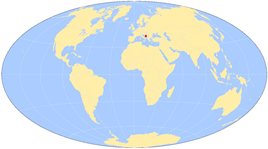
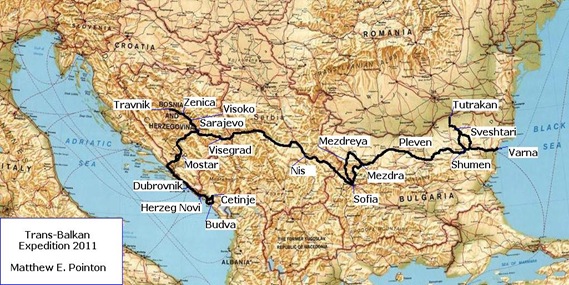


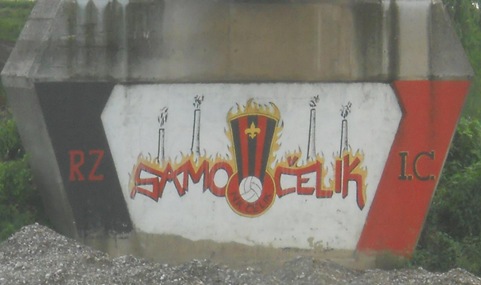
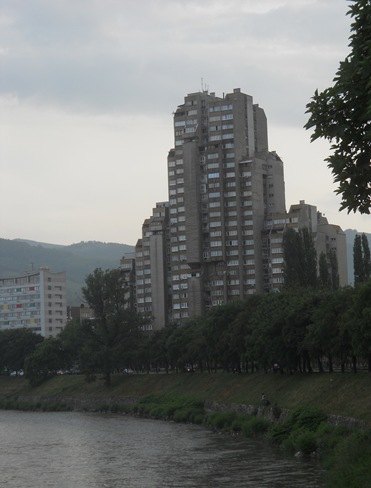
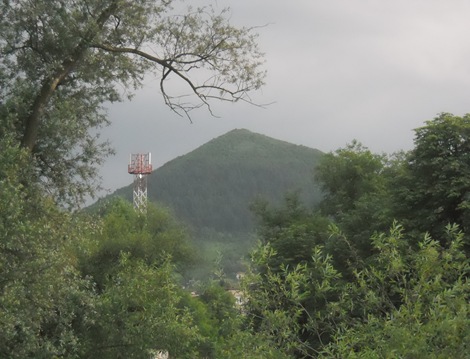
No comments:
Post a Comment